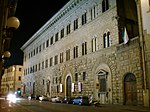Saint Mark (Donatello)
1413 worksMarble sculptures in ItalyOutdoor sculptures in FlorenceSculptures by DonatelloSculptures depicting New Testament people ... and 1 more
Sculptures of Orsanmichele
Donatello's Saint Mark (1411–1413) is a marble statue that stands approximately seven feet and nine inches high and is displayed in the museum of the Orsanmichele church, Florence. It originally was displayed in an exterior niche of the church, where a copy now stands. Donatello was commissioned by the linen weavers' guild to complete three pieces for the project. St. Mark was the first of his contributions. The niche itself was not of Donatello's hand, but created most probably by two stone carvers named Perfetto di Giovanni and Albizzo di Pietro.
Excerpt from the Wikipedia article Saint Mark (Donatello) (License: CC BY-SA 3.0, Authors).Saint Mark (Donatello)
Via dei Lamberti, Florence Quartiere 1
Geographical coordinates (GPS) Address Nearby Places Show on map
Geographical coordinates (GPS)
| Latitude | Longitude |
|---|---|
| N 43.770555555556 ° | E 11.254722222222 ° |
Address
Via dei Lamberti 15 R
50122 Florence, Quartiere 1
Tuscany, Italy
Open on Google Maps










